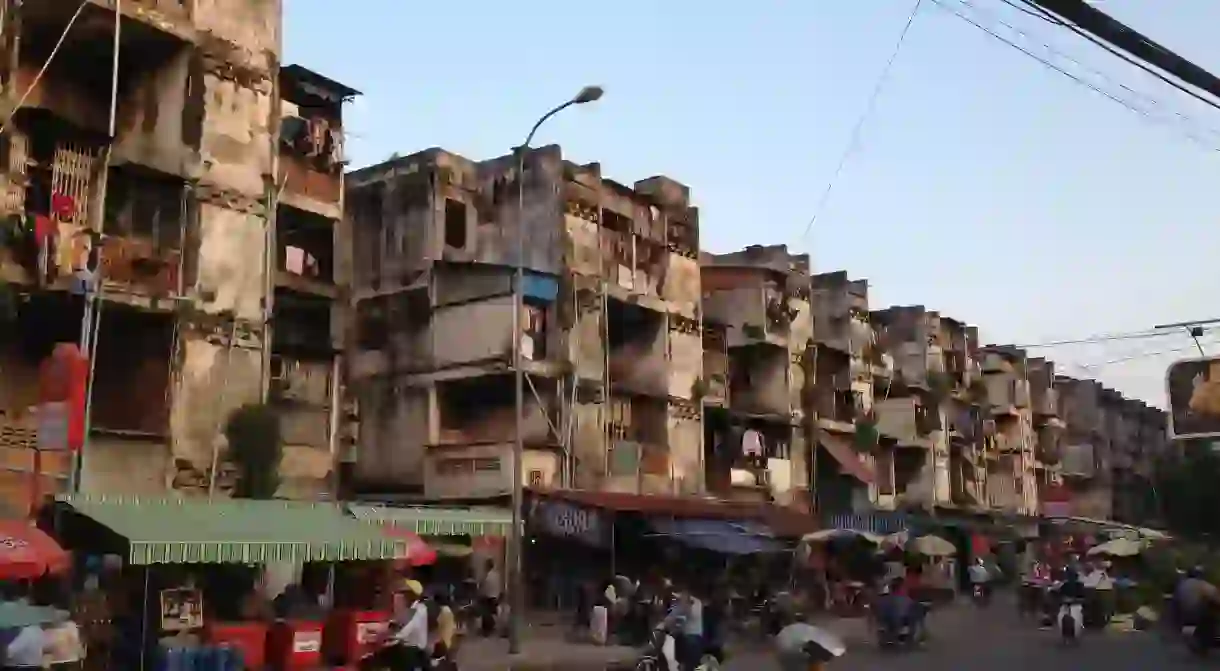Disappearing Architecture: Why These Buildings in Cambodia Are Being Destroyed

As demolition work at Phnom Penh’s historic White Building gets underway, we look at why a slice of Cambodia’s history is disappearing. Despite its shabby exterior, the building harboured a history as intriguing as its dilapidated charm, having survived several chapters of the Kingdom’s life.
As one of the last surviving major testaments to the New Khmer Architecture movement, the White Building formed part of King Sihanouk’s vision to transform Phnom Penh into a modernist hub. To achieve this, he recruited a team of architects in the 1950s and 1960s to create a series of stunning contemporary buildings, monuments and infrastructure across the country.
The architectural revolution was also in response to the capital’s swelling population, which tripled from 370,000 to one million between 1953 and 1970, prompting an urgent need for more public housing. The Bassac Riverfront Project was launched with the aim of overhauling reclaimed land along Bassac River.
The project was overseen by revered Khmer architect Vann Molyvann, who was appointed the country’s chief architect by King Sihanouk, to spearhead the venture after training in France under Le Corbusier. Fellow Cambodian architect Lu Ban Hap and Russian Vladimir Bodiansky were also involved The White Building’s designs.

Opened in 1963, a decade after Cambodia gained independence from France, the building was the country’s first attempt at multi-storey modern urban accommodation for lower- to middle-class Cambodians – mainly artists and civil servants – and comprised of 468 apartments.
Other buildings in the Bassac River Front complex included the Olympic Village Apartments, National Bank Apartments, the Exhibition Hall and National Theatre.
However, Cambodia’s modernisation was halted when the Khmer Rouge took over the country in 1975 and forced all residents into the countryside. In the four years that ensued, almost a quarter of the population died under Pol Pot’s rule, with the majority of the country plunged into horror and ruin.
After the Khmer Rouge were overthrown in 1979, residents started to flock back to the capital, with many of the surviving artists – targeted by the Khmer Rouge, an estimated 95% of the country’s artists were executed or fled – returning to The White Building.
Fresh life was once again breathed into the building as people set up businesses, studios and galleries from their homes, children played out on the street and it was a hive of activity. However, having been neglected and with a lack of public resources available for preservation, the building fell into a state of decay – something that continued until the last of its residents moved out in July this year.
As the years passed by, it became dogged by a reputation for poverty, prostitution, drugs, petty crime and bad sanitation, with more than 2,500 residents crammed into the space. However, many of these were classical dancers, craftspeople, master musicians, artists and cultural workers.
And the building has become a symbol for a Phnom Penh that many officials want to leave in the past. Beyond any state of repair, last year the land was sold to Japanese developers, who plan to transform it into a 21-storey, mixed-use complex. Residents spent months negotiating pay-outs, and were given a deadline of mid-July to relocate to their new homes. The bulldozers rolled in shortly after to tear down this slice of history.

The White Building was the latest in a series of iconic structures to be demolished. While Olympic Stadium (then called the National Sports Complex), the Institute for Foreign Languages, Independence Monument, the Ministry of Finance and Chaktomuk Conference Hall – all Molyvann creations – still stand proud, fears have been raised that not enough is being done to preserve a precious part of Cambodia’s architectural history.
As development sweeps through the capital at a rapid pace and foreign investment floods in, New Khmer Architecture designs are being ripped down and replaced with shiny skyscrapers and luxury condominium towers. Olympic Stadium was sold to a Taiwanese company in 2000 and is overshadowed by development, and The National Theatre and Council of Ministers have been razed, to name a few.

With the aim of preserving the legacy of Molyvann, who still lives in Siem Reap, in 2009 The Vann Molyvann Project was formed. It also raises awareness of the New Khmer Architecture movement, especially among Cambodian architects. As part of the project, an international team of architects, architectural students and other researchers are documenting Molyvann’s creations while documenting the history of the architectural movement, which swept across Cambodia during the 1950s and 1960s.
While the future of the country’s surviving architectural feats remains unsure, for now several buildings remain in tact and can be visited as part of the walking Khmer Architecture Tours in the capital.













